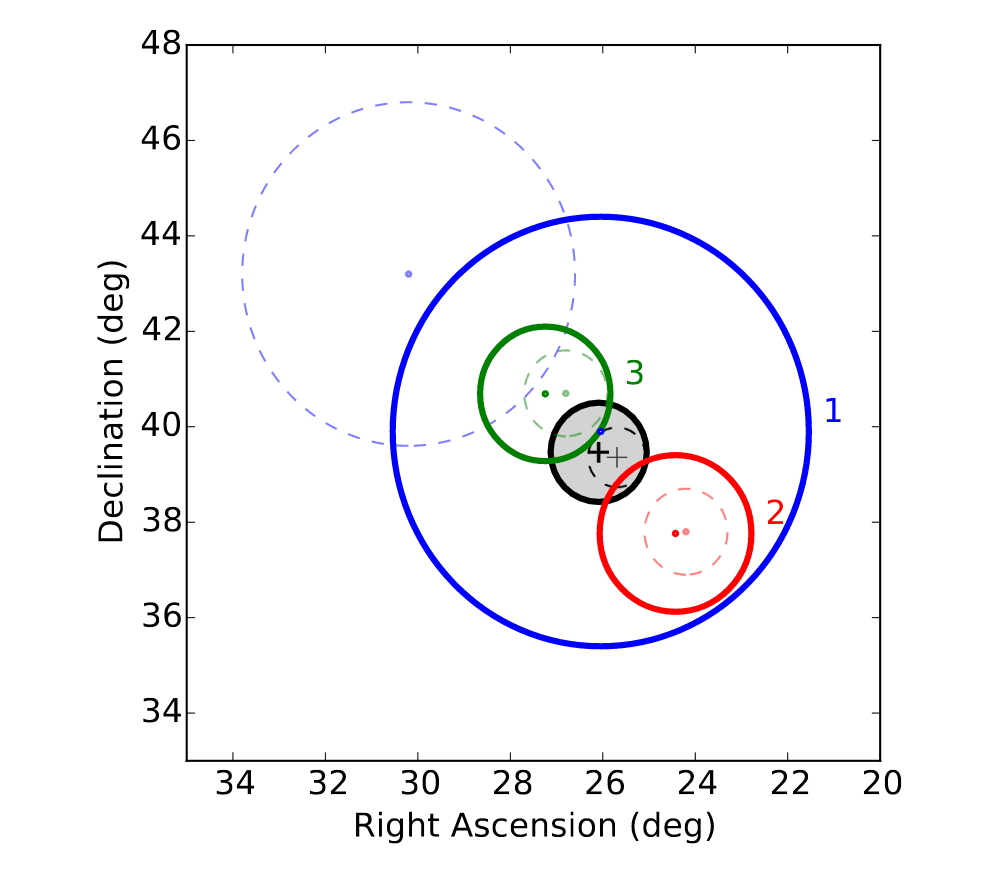The detection of astrophysical neutrinos by IceCube has opened up multiple possibilities for multiwavelength astronomy, powered by alerts of very high energy neutrino events, the so-called HESE+EHE alerts, or the coincidence of two or more high energy neutrinos, also known as the optical follow-up program. Upon receiving these alerts, optical, X-ray, and gamma-ray telescopes can search for the electromagnetic counterpart anticipated for many neutrino sources, such as gamma-ray bursts (GRBs) or active galactic nuclei (AGNs).
On February 17, 2016, IceCube detected the most significant multiplet since the start of the optical follow-up program: three neutrinos appearing within 100 seconds and consistent with a point source origin. Following the alert, eight other observatories searched for associated electromagnetic radiation, from visible frequencies up to gamma rays.
This rare neutrino coincidence has allowed further testing of the capabilities of the IceCube follow-up program, which is able to trigger observations in near real time to search for transient sources. These results have been submitted today to the journal Astronomy & Astrophysics.

The search for coincidences of high-energy neutrino events is not new. In fact, there are many studies that have looked for them, and even a few have provided a glimpse but not one that could be confirmed.
A neutrino triplet such as the one observed in early 2016 is expected only once every 13.7 years, but scientists had several reasons to be cautious.
– IceCube has been running this follow-up program for several years now, with an integrated probability of 0.38 of seeing a neutrino triplet of atmospheric origin.
– The associated neutrino doublets had not triggered an alert on their own, and the triplet had not been immediately identified because the angular separation was slightly above the trigger cut.
– Had the triplet been reconstructed with improved algorithms, which have been used for IceCube neutrino alerts since May 2016, it would not have triggered an alert.
However, although the triplet could have been produced by atmospheric neutrinos, there was a chance that a nearby or an extremely energetic source was the origin of these three neutrinos. Examples of these sources could be a core-collapse supernova (CCSN), a GRB, or an AGN flare.

Three optical observatories, the All-Sky Automated Survey for Supernovae (ASAS-SN), Las Cumbres Observatory (LCO), and the Mobile Astronomical System of the Telescope-Robots (MASTER) searched for emission at the time of the alert and also evaluated data within 30 days before the neutrino triplet.
Two X-ray telescopes aboard the Swift satellite, the X-ray Telescope (XRT), and the Burst Alert Telescope (BAT) observed the position that the neutrino triplet came from within a minute after its detection.
Three gamma-ray observatories, namely the Large Area Telescope aboard the Fermi Gamma-Ray Space Telescope (FermiLAT), the Very Energetic Radiation Imaging Telescope Array System (VERITAS), and the High-Altitude Water Cherenkov Gamma-Ray Observatory (HAWC), also looked for a possible counterpart electromagnetic emission.
All these observations failed to detect any electromagnetic radiation in conjunction with the IceCube neutrino triplet. The optical observations ruled out a nearby CCSN, while X-ray telescopes excluded brighter than average GRBs and the nondetection in gamma-ray observatories also precluded AGNs.
With this work, the IceCube optical follow-up program has shown a tremendous discovery potential for multiwavelength astronomy. Improvements of the algorithms and the addition of new observatories, including gravitational-wave telescopes, will increase the sensitivity and the types of sources that can be detected with follow-up multimessenger searches.
Excitement is guaranteed. Hang on for more news!
+ info “Multiwavelength follow-up of a rare IceCube neutrino multiplet,” The IceCube Collaboration, ASAS-SN, The The Astrophysical Multimessenger Observatory Network, Fermi, HAWC, LCO, MASTER, Swift, VERITAS, et al. Astronomy & Astrophysics 607 (2017) A115, www.aanda.org arxiv.org/abs/1702.06131